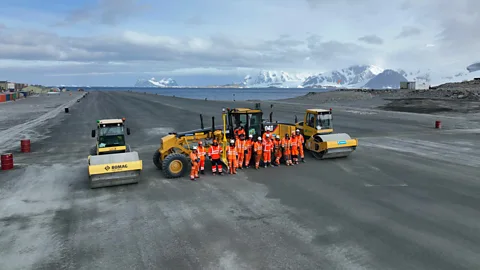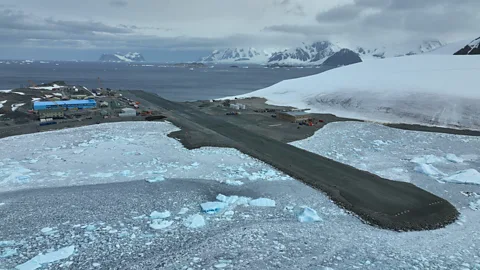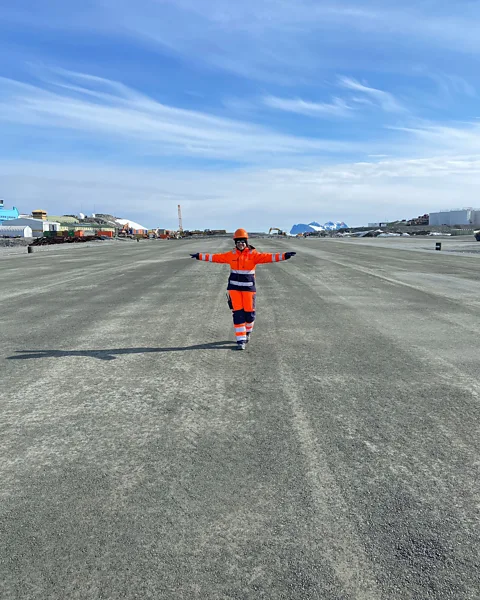How to fix a runway in Antarctica
 BAM
BAMIn the coldest place on Earth, workers wage an epic battle with the extreme landscape – aided by specially trained penguin-movers.
Jimmy Bellis looked out of the window of the small Dash-7 aircraft he was travelling in, taking in the otherworldly Antarctic snowscape below. "Up there, in the air, it was clear. It was calm, and so vast," he remembers, speaking via video call from Antarctica. "The landscape doesn't change until, eventually, the runway comes into view and suddenly you get that ground rush."
Rothera airstrip, on Antarctica's Adelaide Island, is a dash of grey amid the seemingly endless expanse of snow and ice. It serves the largest British Antarctic facility, Rothera Research Station, a centre for biological research, and the 100 people who live and work there during the summer months. In the Antarctic summer, which lasts from October to February as the continent is in the southern hemisphere, the runway is surrounded by water. When the last smudge of yellow fades to grey as the sun dips below the horizon, the Antarctic winter sets in – and just 22 people can be found living at the station. In the months of darkness, persistent surface winds rush from snow-covered plateaus downwards towards the coast, and freezing temperatures as low as −128.6°F (−89.2 °C) grip this land of ice.
Now, work has begun to modernise the 32-year-old airstrip. Bellis, who heads up the air infrastructure project – and the airstrip upgrade – for the British Antarctic Survey (BAS), has been in Rothera for three weeks to supervise this unique construction challenge. Among the main difficulties: the Antarctic weather, and the ever-changing landscape.
One particularly windy day, Maria Gonzalez Rico, associate at engineering firm Ramboll and lead designer on the Rothera Runway project, walked along the runway to inspect some of the upgrade work. The runway is just 900m (3000ft) long and the stroll, which would normally take just 10 minutes, took more than half an hour due to the force of the wind blasting her backwards.
"I was thinking 'what am I doing here?'," Gonzalez Rico remembers. "Anything above 20 knots (37km/h or 23 mph) – and we knew it was going to be a hard working day." The following day, though, the sun shone in a clear blue sky and glittered on the pristine snow. "You get out and see the surroundings, and it reminds you – that's why. It was an incredible experience, absolutely."
 BAM
BAMGonzalez Rico recently spent six weeks in Antarctica. "This was probably the highlight of my career so far," she says. "It was quite a leap from building, say, a road in Britain."
As the windiest, coldest place on the planet, Antarctica is not a natural habitat for humans. The continent is the only one on Earth with no indigenous population, and the land can't sustain any wildlife bigger than a midge – the penguins, seals and other creatures all live in the waters surrounding the icy continent . However, there is a community of hardy scientists and support staff that fluctuates from around 5,000 in the summer months to just 1,000 in the winter. Their supplies are usually brought in by ship, but the people tend to arrive by air.
You might also like:
The extreme weather and changing landscape do not allow for conventional runway construction. Snow and ice move, melt, freeze. Glaciers flow. Because of this, runways in Antarctica are not your usual runways. Some are made from groomed blue ice and some from compacted snow. Ski-ways allow for planes with skis instead of wheels.
Many of Antarctica's landing strips rely on design and technology dating back to the 1950s when Antarctic operations expanded rapidly. Since that time, polar exploration and research have continued to increase, along with the massive logistics operations that underpin them. For every day of research, nine days of logistics effort are required. In Antarctica, even basic logistical tasks like housing and feeding people can be a daily challenge, for example when storage facilities are buried in snow. (Read how the researchers' extreme isolation has even resulted in the formation of an Antarctic accent and slang.)
In this unique and fragile environment, special attention has to be given to assess any possible risks of construction work. The potential impacts of increased noise, dust, waste, light, fuel, and disturbance to native flora and fauna had to be considered, and strict guidelines adhered to.
"You see penguins and seals all the time," says Gonzalez Rico, "but there are very clear instructions what to do and what not to do if you encounter wildlife." If seals or penguins need to be moved out of the way, trained personnel are on hand to do it – but no more than five times a day per species. "The main thing to understand," Gonzalez Rico adds, "is this is their home, not ours. They take priority over anything else."
The major challenge of construction work in Antarctica, says Gonzalez Rico, is planning. "It took two and a half years," she says. "We went through every single possible scenario, and based the programme of works on the worst case scenario." And it paid off, she says. When snowfall came, the team were able to change what they were working on until the weather improved.
Efficiency is paramount since they need to complete certain jobs before the austral winter (the winter months in the southern hemisphere), when construction work outdoors becomes impossible.
"We have a great team of meteorologists," adds Bellis. "One evening, we were made aware there was snow on its way. By the time we woke up in the morning there was about 10cm (4in) of snow across the whole of Rothera, including the runway. There's nothing you can do. It's all about being able to adapt and get ready for when that snow is cleared enough to carry on."
As part of the Antarctic Infrastructure Modernisation Programme (AIMP), which launched in 2017, the first thing the runway team worked on was upgrading the runway lighting, which is now more energy efficient than the old lighting, and maintains safe and reliable flying operations into Rothera. Next, the team began work to resurface the runway, increase its length by 17m (56ft) to 903m (2963ft), and add a turn pad.
 Ben Checkley/BAS
Ben Checkley/BASExtreme Repairs
Extreme Repairs is a BBC.com series about the world of big infrastructure repair and maintenance, featuring the brave men and women who risk their lives to keep us all safe and connected.
Rothera runway is made of all natural materials, all sourced from Antarctica. Crushed rock is used in place of snow or ice, because of the warmer temperature of Rothera compared to other parts of Antarctica, says Gonzalez Rico. "You get defrosting of the ice [in summer], so it's always been gravel – and the rock here is of amazing quality."
First, the team crush the rock into different sizes. "It goes from bigger rock at the bottom to smaller rock at the top, to minimise impact on the aircraft," says Gonzalez Rico. Any bigger than 16mm (0.6in) at the top, she says, and the aggregate at the surface will move. "The smaller the better for the safety of the aircraft," she says.
The surface is bound using sea water. "Once the water evaporates, you're left with just the salt," says Gonzalez Rico. "It's a natural bind, and there's plenty of it around, so it couldn't be more sustainable."
The team also need to adjust the camber, or slight curve, of the runway surface, to allow for water runoff. When winter snow begins to thaw, around October time, meltwater that doesn't drain away could not only damage the runway but pose a risk to aircraft safety.
"You can clear the snow off [the runway]," says Bellis, "but then you have a layer of ice that needs to be left untouched. You can't bring that up without damaging the surface. So, from that point we need to melt the ice. The quicker we can get the water off, the quicker we can start getting the resources flown into Rothera."
Snowboarding in Antarctica
Life at the research station is comfortable, Bellis says. "The food is really good. We have a library, TV room and bar. There are boardgames. There's plenty to do if the weather's bad."
The weather, says Bellis, can vary wildly from day to day. "[Some days] I open the door and the sun's glaring in my eyes, and I find I have too many clothes on. [Other times] it's snowing. This morning the wind was coming through, which really changed the temperature."
When the weather is good, there are activities like visits and boat trips, or workers are free to go out and experience Antarctica's wilderness. "There is a really good atmosphere," says Bellis. "It was my birthday on Sunday, and I managed to grab one of the snowboards and go up onto the slopes."
 Ben Checkley/BAS
Ben Checkley/BASRothera Research Station houses biologists, meteorologists, field assistants, engineers, mechanics, electricians, plumbers, builders, a chef, a doctor amongst other staff – and the runway serves as their only "air-bridge" to the rest of the world. What may feel a lonely and faraway place, however, is in fact deeply connected to the Earth system, and the runway is essential for some of Rothera's core scientific missions, researching Antarctica's crucial role in the health of our planet.
As cold water upwells from the deep ocean, tiny organisms rise to the surface. Known as phytoplankton they photosynthesise, absorbing CO2 from the atmosphere before sinking once more to the depths.
"Antarctica is part of the Earth system," says atmospheric chemist, Anna Jones. "We are realising more and more how connected the Earth is, by ocean and atmospheric circulation. The biosphere – the plants and animals – are connected to the atmosphere. They're connected to the weather. And, if you think about the polar regions, the ice is connected to the atmosphere and it's connected to the ocean. These oceans are connected to other ocean basins, and the atmosphere [here] is connected to the atmosphere in other parts of the world."
Jones has spent her 30-year career researching interactions between the atmosphere, and snow and ice in the polar regions. Today, she's director of science at British Antarctic Survey.
Antarctica, she says, is vitally important to Earth's climate and oceanic circulation systems. Sea ice helps keep global temperatures stable by reflecting solar radiation from its bright, white surface. And the Southern Ocean is the world's largest heat and carbon sink, capturing almost three quarters of human induced warming and one fifth of manmade carbon.
Antarctic sea ice also acts as a buttress, protecting glaciers and coastal ice sheets from destructive ocean waves. If broken up, the loss of these could lead to drastic worldwide sea level rise. The Southern Ocean is vitally important for marine life, too, ranging from microscopic algae to krill, fish, seabirds, seals and whales. Already, declining levels of sea-ice have had cascading effects on food-webs and biodiversity. And, experts warn, future changes to the Southern Ocean ecosystem would have consequences felt throughout the entire Earth system.
"Ice is being lost in areas which are critical," says Jones. "Antarctica is responding to global change – but the changes in Antarctica will affect the rest of the world."
Rothera has a fleet of five aircraft, specially adapted for flying in the extreme Antarctic climate, and equipped with modifications to allow them to carry out airborne science missions.
The Defiant project, says Jones, recently did "a really neat experiment" out of Rothera. "There are satellites that look down from orbit, and take measurements of sea ice thickness, but you also need measurements from different platforms."
The team, she says, worked with the European Space Agency (ESA) to take measurements from two satellites that passed over Rothera simultaneously. At the same time, they flew from Rothera, taking the aircraft backwards and forwards across the track of the satellites, measuring the same patch of sea ice.
"They'll compare all the data, and use it to anchor those different measurements together," says Jones. "From that, they can build up an understanding of sea ice changes across the whole of the Antarctic."
 Getty Images
Getty ImagesRothera is also a launch pad for deep-field and air operations. During any Antarctic field season – the austral summer months – BAS aircraft can fly for thousands of kilometres, often deep into the continent or high onto the Polar Plateau, the large, ice covered region around teh South Pole in East Antarctica.
Take the Southern Ocean Clouds project, says Jones, which aims to improve our understanding of the formation of high-latitude mixed-phase clouds. These clouds offer some of the biggest remaining uncertainties in climate modelling.
Clouds can both reflect sunlight "because they're white on top", says Jones, and also trap outgoing radiation from the Earth's surface. So, clouds can both warm and cool the Earth.
"There's a lot we don't understand about what causes the formation of these clouds over the Southern Ocean," she says. "The aircraft fly from Rothera, out over the ocean and into the clouds. They're looking for sources of things that can nucleate cloud particles." Clouds, says Jones, sometimes need small particles in the atmosphere to grow on, such as biological particles or chemicals that may come from the ocean.
In the midst of the climate crisis, scientists are still discovering many of Antarctica's secrets, and we are only just beginning to understand its global significance.
For Bellis and his team, facilitating these scientific discoveries is ultimately what their unique construction project is all about. "The main thing," says Bellis, "is that [the runway] will be safer. It's going to allow us to get more people in and out to Antarctica, and out [from Rothera] to the outlying regions – to conduct this vital research."
--
If you liked this story, sign up for The Essential List newsletter – a handpicked selection of features, videos and can't-miss news delivered to your inbox every Friday.
